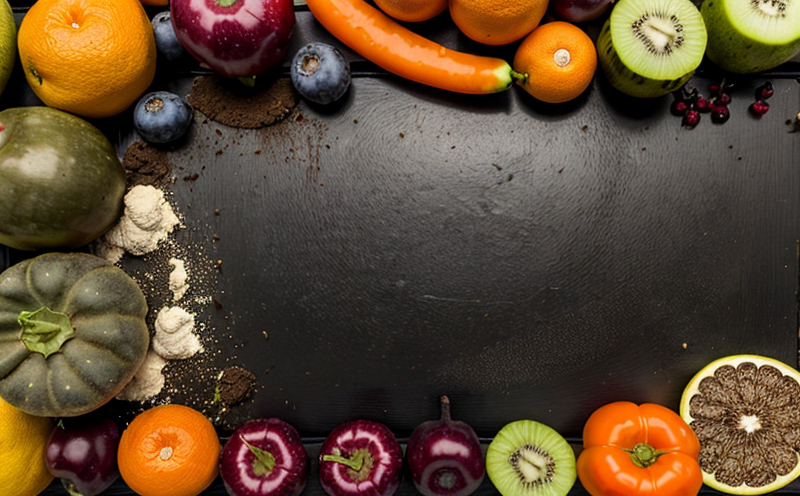ASTM E1215 Texture Analysis in Fruits and Vegetables
The ASTM E1215 standard is a widely recognized method used to determine the texture of fruits and vegetables. This service plays a crucial role in ensuring that food products meet quality and safety standards, which are essential for both consumer satisfaction and regulatory compliance.
The ASTM E1215 Texture Analysis involves measuring the force required to compress or shear a specimen cut from the fruit or vegetable. The texture profile analysis (TPA) technique is particularly useful for understanding how different varieties of fruits and vegetables behave under mechanical stress, which can influence their shelf life, consumer acceptance, and overall quality.
The process begins with selecting appropriate specimens that represent the characteristics to be tested. Specimens should ideally be cut from the center of the fruit or vegetable to minimize variability. The cutting method must also ensure uniformity across all samples being analyzed. Once prepared, these specimens are placed into a texture analyzer equipped with suitable probes for compression.
After setting up the sample and probe, the instrument applies a controlled force that measures both hardness and cohesiveness. Hardness refers to resistance against deformation while cohesiveness indicates how well parts stick together after deformation. The results provide detailed insight into the mechanical properties of various fruit and vegetable types under different conditions.
Understanding these parameters helps food manufacturers optimize processing techniques, develop new products tailored to specific market needs, or simply maintain consistency across their product lines. By adhering closely to ASTM E1215 guidelines, laboratories ensure accurate measurements that contribute significantly towards maintaining high standards of quality and safety in the global food industry.
For instance, this service can aid in determining optimal storage conditions by identifying which fruits or vegetables would benefit most from refrigeration versus room temperature storage. It also assists in selecting appropriate packaging materials capable of protecting delicate produce during transport without causing damage through excessive pressure.
The ASTM E1215 Texture Analysis is not only beneficial for quality control but also supports research aimed at improving agricultural practices and plant breeding programs. Through continuous improvement based on texture analysis results, farmers can grow healthier crops better suited to withstand environmental stresses like drought or pests. Additionally, this service contributes valuable data points that help food scientists innovate in areas such as functional foods designed specifically with improved digestibility.
In summary, ASTM E1215 Texture Analysis serves as an indispensable tool for ensuring consistent quality and safety in the production of fruits and vegetables. It provides actionable insights into optimizing processing methods, enhancing product development efforts, and promoting sustainable agricultural practices—all critical factors contributing to a thriving food industry.
Scope and Methodology
| Parameter | Description |
|---|---|
| Test Specimen Preparation | Cut specimens from the center of fruits or vegetables ensuring uniformity. |
| Instrumentation | Use a texture analyzer equipped with suitable probes for compression tests. |
| Data Collection | Measure force required to compress or shear the specimen, recording hardness and cohesiveness values. |
| Analysis | Determine optimal processing conditions based on collected data; evaluate texture profiles against established standards. |
The ASTM E1215 Texture Analysis method encompasses several key steps starting with proper sample preparation. Specimens are carefully selected and cut according to specified dimensions, ensuring consistency throughout the testing process. Next comes instrument calibration followed by placing prepared samples into a texture analyzer fitted with appropriate probes.
Data collection involves applying controlled forces to measure both hardness and cohesiveness of each specimen type. These parameters provide essential information regarding how various fruits or vegetables behave under mechanical stress conditions typical during processing, handling, or consumption. Finally, the collected data undergoes rigorous analysis to identify trends, set benchmarks for quality standards, and guide improvements in agricultural techniques as well as product design.
Environmental and Sustainability Contributions
- Reduced Waste: By optimizing processing methods informed by texture analysis results, food manufacturers can reduce waste associated with overripe or damaged produce. This leads to more efficient use of resources throughout the supply chain.
- Energy Efficiency: Understanding how different fruits and vegetables react under various environmental conditions allows for better energy management strategies within processing facilities. For example, knowing which items require cold storage minimizes unnecessary refrigeration costs.
- Sustainable Packaging Selection: Identifying the ideal packaging materials through texture analysis helps prevent excessive use of non-recyclable containers while promoting recyclability and biodegradability where possible.
The ASTM E1215 Texture Analysis service contributes positively to environmental sustainability by encouraging practices that minimize resource consumption, reduce waste generation, and promote recycling initiatives. These actions align with broader goals set forth by international organizations focused on reducing carbon footprints across all sectors of the economy.
Competitive Advantage and Market Impact
The ASTM E1215 Texture Analysis service offers significant competitive advantages for companies operating within the food & feed testing sector. With precise measurements and detailed insights into product textures, businesses can differentiate themselves in crowded markets by offering superior quality products backed by scientific evidence.
By leveraging texture analysis data, firms can develop innovative solutions tailored to specific market segments or consumer preferences. For example, manufacturers may focus on creating snacks that appeal more strongly to younger demographics who have different expectations regarding crunchiness and sweetness levels compared to older consumers.
The service also enhances supply chain transparency by providing clear metrics for quality assurance purposes. This added level of confidence fosters trust between suppliers and buyers, leading to stronger relationships built upon mutual respect and shared goals towards excellence in food safety and quality.
Moreover, companies adopting ASTM E1215 Texture Analysis early on position themselves ahead of competitors who still rely solely on subjective judgments about product texture. As standards continue evolving globally, those already incorporating advanced techniques like this one stand to gain first mover benefits in terms of innovation leadership and customer satisfaction.





